George Garcia walks through the wig section of his costume store. He passes the aisle of new George Washington and “Renaissance maiden” styles, packaged in clear plastic with full-color photos and bright lettering, and pauses at a rack filled with wigs in old Ziploc bags. Many of them are unlabeled and covered with a light film from their years on display. Garcia shakes a slippery black mop out of one bag and gently handles it until the wig takes shape, revealing a blunt-cut bob with a dense row of fringe across the forehead.
“This is a Cleo,” he says, and it should cost at least fifty dollars. Garcia looks for a price tag, doesn’t see one, and puts Cleopatra back with the other wigs, none of which appear to have price tags either. “This will last forever if you don’t put a lot of heat to it.”
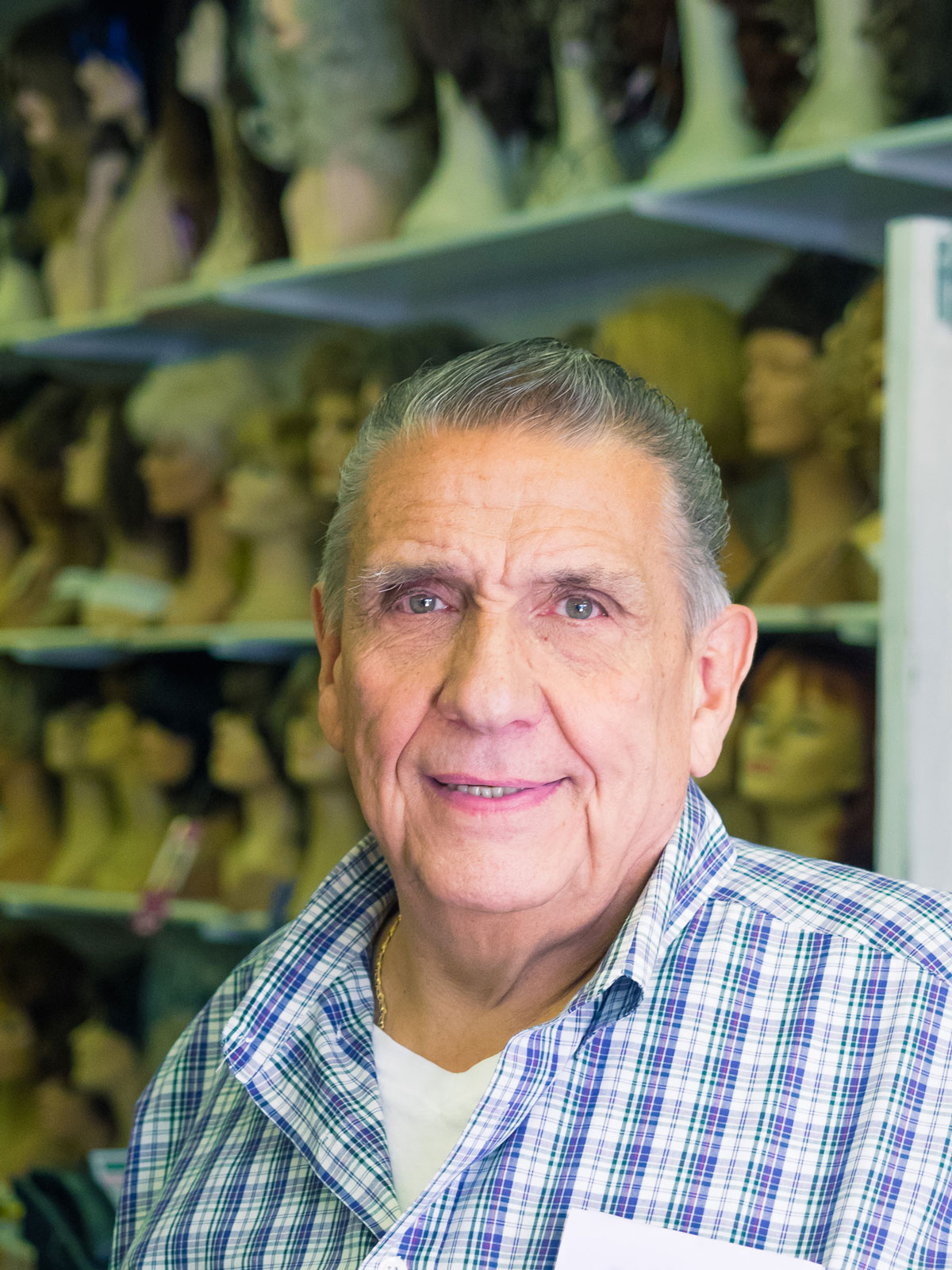
Garcia knows something about making something permanent out of merchandise that others might view as disposable. He got his start in wigs, selling them first from the trunk of his car in the 1960s, and later from five stores in Chicago. The last one, opened in 1969, was on the city’s northwest side in an area called Six Corners for the three major streets that intersect there. It’s the only storefront Garcia kept after closing his other locations in the early 1970s. What began as Custom Wigs became Fantasy Costumes, a sprawling store that occupies an entire city block and sells everything from clown shoes to mint-flavored fake blood to outfits for dogs, all year round. Even after weathering an economic slump in Six Corners and competition from pop-up Halloween shops and online retailers, Garcia’s mission hasn’t changed since his wig-selling days: Help the customer look great, have fun and get a little crazy.
“If I have a thousand afros styled up all nicely, I’ll sell them all during Halloween time,” he says. “Because people see the style, they put ’em on, it looks good, you look hot, you look super fine. … Everyone’s happy. And they get compliments, trust me. There’s a lot of seventies parties out there.”
Halloween accounts for about 40 percent of Fantasy Costumes’ annual sales, and the shop is open 24 hours a day for the two weeks leading up to Oct. 31. But Fantasy Costumes has established itself as a year-round authority on all things dress-up. Its customers include television and film crews shooting in the area, pop culture enthusiasts attending the Chicago Comic & Entertainment Expo (C2E2) or Wizard World, and nightclubs outfitting their staff for themed events — “Maybe they have hooker night or Star Wars,” Garcia says. Even Taylor Swift dropped by in 2009 and bartered six front-row tickets to her concert that night for a $700 pink flamingo costume.
Turkey and Santa Claus rentals start right after Halloween. Then comes Mardi Gras and Easter; Garcia estimates the store rents out at least 200 bunny costumes every year. There’s also the Jewish holiday Purim, which commemorates the deliverance of the Jewish people from the Persians. Children traditionally dress up in costumes for the occasion.
“We see bumps at Purim. You know what Purim is?” Garcia says. “The Jews love my store. I say it the way it is!”

Garcia, who turns 74 in February, discusses people’s ethnic origins with a nonchalance that reflects his upbringing in an era before political correctness. He was born and raised in Uptown, a Chicago neighborhood that attracted a large immigrant population and surrounded him with extended family and friends from varied cultural backgrounds. When Garcia entered the wig business, he was often the lone non-black face on the sales circuit as he visited hair salons and trade shows. He liked making the rounds, meeting different people and joking with customers, much as he does now at his store.
Ed Bannon, executive director of the Six Corners Business Association, gives Garcia credit for his long-standing friendliness toward the LGBT community.
“Maybe it was just his business, but it’s also part of his personality,” Bannon says. “I think generationally, he’s ahead of his time.”
Garcia says he used to run an ad for his store saying “TVs are welcome.” He meant transvestites (now an outdated term), but one day a woman walked in with a broken television set. That was one of the few times Garcia disappointed a customer. On the costume front, it’s hard to imagine where he would fall short. Need a rubber Kim Jong-un mask? Fishnet stockings that fit a 350-pound person? A classic snake nut can? Garcia has them all, and he’s also happy to make special orders.
This is a fun business and you gotta be able to help people.
One afternoon, a shopper can’t find the “breast cancer pink” feather boas he wants for a black-tie gala. Garcia gets his boa guy — “He’s a personal friend. They’re all personal friends!” — on the phone within minutes and orders more than 60 pieces in assorted colors. The customer, relieved he won’t have to pay shipping for an online purchase, agrees to return next week to pick up the boas.
“This is a fun business and you gotta be able to help people,” Garcia says. “Like even if I don’t know what I’m talking about, I wing things sometimes.”
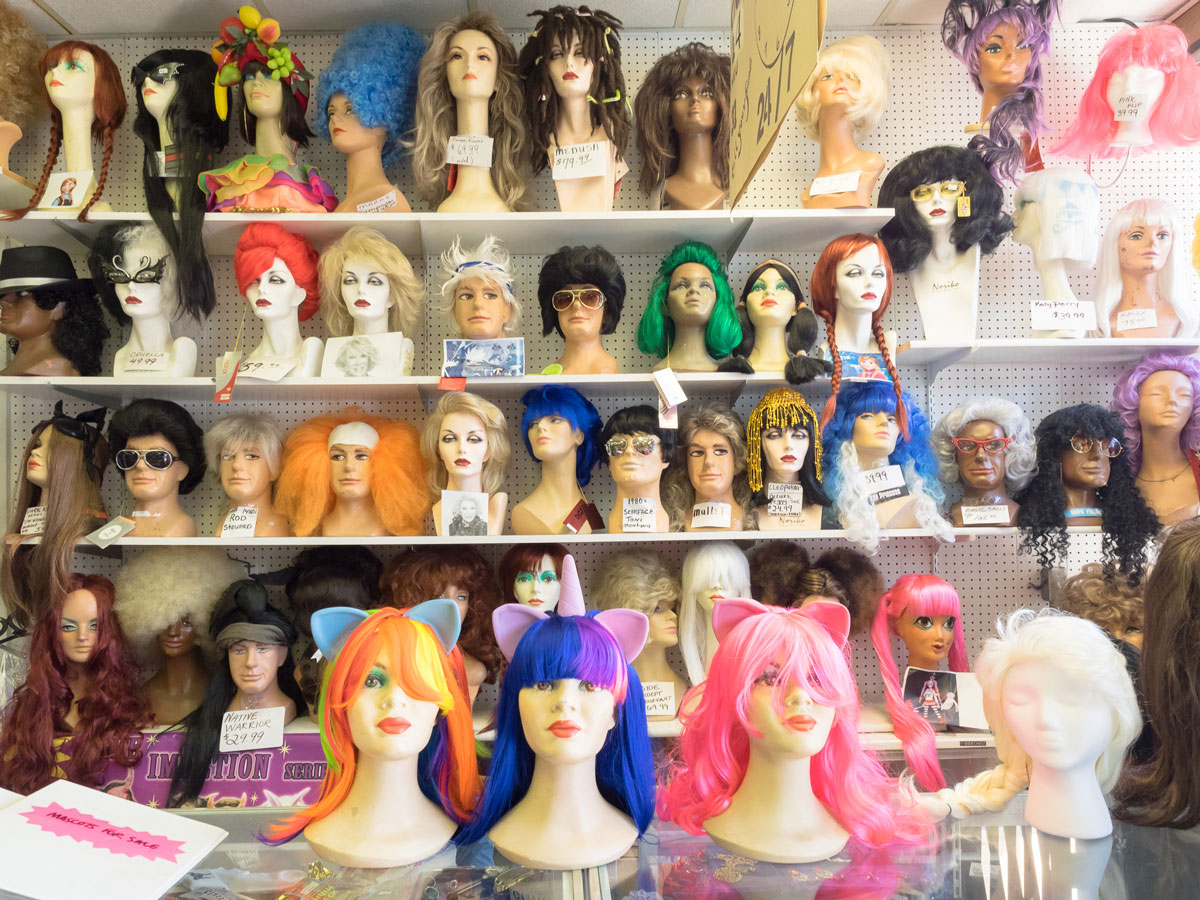
Garcia has been winging it for almost 50 years, adapting to changes in the business and the neighborhood. The shop used to sell and service wigs for people who’d lost their hair from chemotherapy or alopecia. To lighten the mood, Garcia started styling wigs for Halloween. Before long, he was stocking theatrical make up, costumes, and novelty items. Today the store continues to service wigs and fit men’s hairpieces upon request. Garcia’s wife, Mary, who works at the store, still answers the phone “Fantasy Costumes and Custom Wigs.” But costume sales and rentals are the big draw today.
“Gradually I just started making it a crazy store, you know?” Garcia says.
Corner store, cornerstone
The interior of Fantasy Costumes, like its history, has an ad hoc quality. When neighboring businesses closed, Garcia took over their storefronts and now has about 18,000 square feet of floor space, plus another 20,000 square feet of storage. The shop has a pleasantly musty smell and there’s a basic sense of order — kids’ costumes near the front, wigs and masquerade masks in the back, the sexy room on the southern end — but the space barely contains the merchandise explosion. The store adds about 1,000 new items every year. It used to stage an elaborate graveyard tableau every Halloween, complete with costumed staff hiding among the props to jump out at customers, but had to get rid of the display to make room for more products.
Unlike the temporary Halloween stores that are common sights in strip malls, springing up in the shells of extinct big-box retailers, Fantasy Costumes stocks more than just what’s popular for the current season. The store’s inventory represents the amalgamation of nearly a half-century of Halloweens and other holidays.
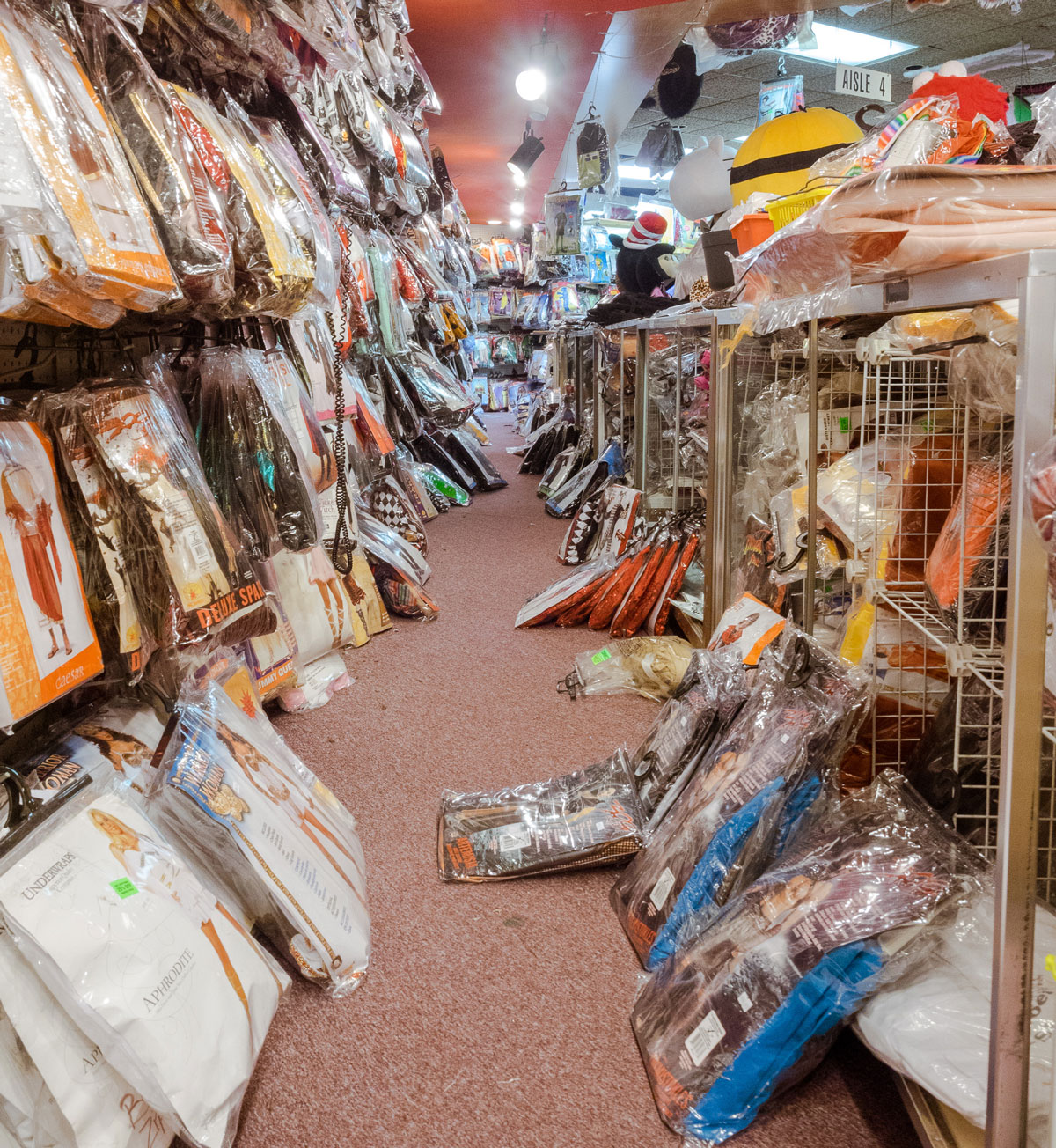
Garcia prides himself on the store’s deep selection and knowledgeable staff. His employees can custom-style a wig, offer stage make-up application tips or locate a specific item — a crucial skill. How else would a customer know that the costumes from “Sharknado,” the Syfy channel’s B movie hit, are in the animal-themed aisle, by the Eeyore headbands and ladybug wings? Or that the “Duck Dynasty” Willie costume ($39.99 for a bandana with attached wig, beard and camouflage vest) is in the facial hair aisle with the faux mutton chops and Pancho Villa mustache kits?
Most of the year, Fantasy Costumes employs about 20 people. That number rises to nearly 100 during Halloween to manage the 24/7 crowds. Garcia says his shop’s customer service also sets it apart from Halloween pop-ups.
“Those people just hire people at eight, ten bucks an hour or whatever,” he says. “You ask questions, they don’t answer. (Here), Amy knows everything. Irma knows everything. I can’t think of her name — Amanda! Amanda knows everything. Ray, he’s not here, he knows everything. Jay, a Filipino guy, knows everything. They know what’s going on.”
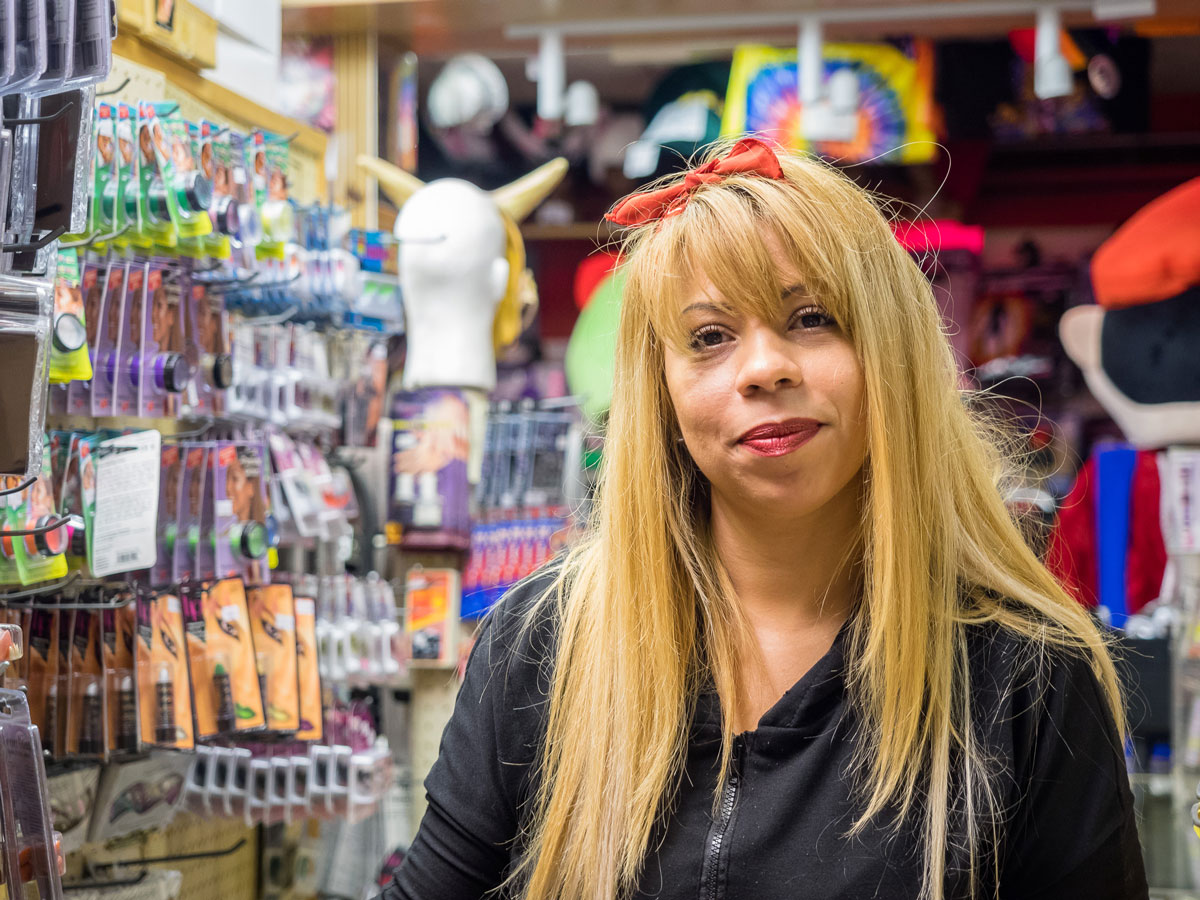
Garcia once referred to pop-up Halloween stores as “a bunch of carpetbaggers” in an interview with the Chicago Tribune. That was 10 years ago. Today, he just sighs and says, “I don’t know, they hurt everybody. If that’s what they want to do, that’s what they’re going to do. They’re going to take away some business.”
In reality, the temporary Halloween store has been around for decades. Spirit Halloween, which operates more than 1,000 shops around the country between Labor Day and November 1, opened its first location in the Bay Area in 1983. The struggle today is shifting from pop-up versus permanent to brick-and-mortar versus online. Both Spirit and Halloween Hallway, a temporary retail operator with several stores in the Chicago area, do year-round online sales. Another local store, 38-year-old Chicago Costume, sells merchandise through its website.
You’ve got to use your mind to get this thing going, especially with my overhead — with all this space. Look at this space!
Fantasy Costumes now does some e-commerce, including selling through Amazon. “You’ve got to use your mind to get this thing going, especially with my overhead — with all this space. Look at this space!” Garcia says. “I have over 30,000-some square feet. Everything’s lock stock paid for. It helps, but my taxes are one hundred thousand dollars a year here. … Nine thousand-something a month. Figure that one out!”
Six Corners was once one of the city’s largest shopping destinations. Developed as a commercial district between the 1920s and the 1940s, the corridor has struggled in recent decades with vacant storefronts and aging infrastructure. Bannon of the Six Corners Business Association says the area is now recovering and credits Garcia’s store, along with a 76-year-old Sears and a specialty magazine shop called City Newsstand, for sustaining the neighborhood during its fallow period.
“Fantasy is one of the businesses that has saved Six Corners because it’s always been there as an anchor,” says Bannon, whose purchases at the store include a butcher knife, a white robe for playing God, and outfits for his children’s talent shows. “It’s at least one business we could always point to, to show that Six Corners can be a successful area.”
Has Elvis left the building?
After almost 50 years in business, Garcia both shapes and anticipates Chicago’s Halloween trends. Because the store places most Halloween orders between January and March, his staff has to predict what pop culture phenomena will be popular by fall. Duds from the past decade include Star Wars clone troopers and tie-ins from “Indiana Jones and the Kingdom of the Crystal Skull.” On the flip side is anything related to “Frozen,” and not just girls’ Elsa costumes. The current hot rental at Fantasy Costumes is an enormous snowman that bears an uncanny resemblance to Olaf, the snowman from “Frozen,” and costs $125 a day.
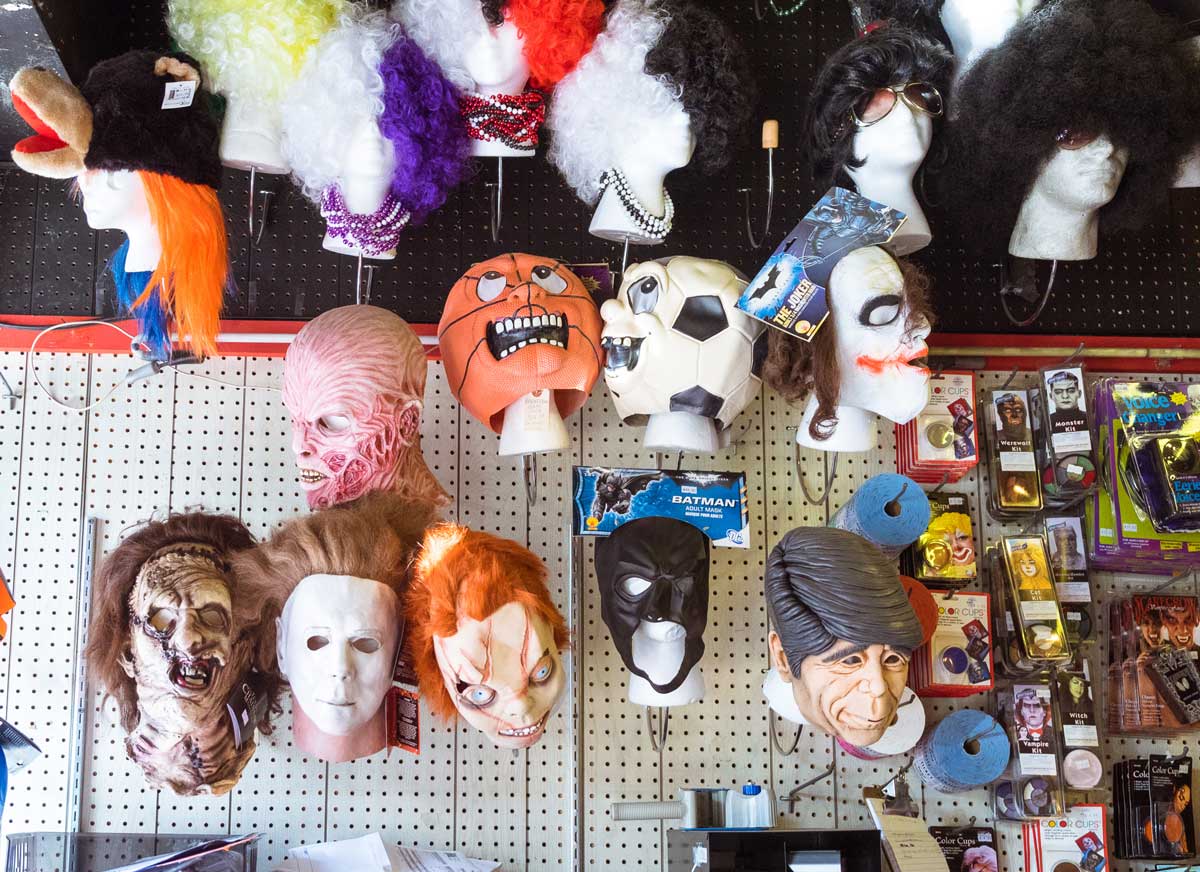
Garcia has conceived some of the store’s best-sellers himself. In 2010, he commissioned a mask of Illinois’ felonious ex-governor, Rod Blagojevich, down to the disgraced politician’s meticulously styled coif. Blagojevich doesn’t have the evergreen appeal of, say, horror movie icon Michael Myers, whose white visage continues to sell several hundred units every season. But Blagojevich masks ($34.99 each) still lurk at the store, with one by the front register and another in the mask room, near Barack Obama and Chicago Mayor Rahm Emanuel. (The latter mask, Garcia notes, is popular with public schoolteachers whenever their union is feuding with the mayor’s office.)
Fantasy Costumes has no computerized inventory system. Employees jot down out-of-stock items on a legal pad in a clipboard behind the front counter. Asked why he hasn’t invested in a computer system, Garcia pretends to call a supplier: “‘We need 15 Elvises, the code is 22224.’ (The supplier says) ‘OK, we’ll ship them out tomorrow.’ Five days later, where are they? ‘Oh, we didn’t have them in stock. The computer said we had ’em, but (an employee) forgot to take ’em off.’

“I ain’t going through this. You follow me?” Garcia says. “Not in this stage in my life. Next generation? Do whatever you want to do. The world is your oyster. The store is your oyster. Okay, let’s meet Chuck!”
Chuck Giovenco, general manager at Fantasy Costumes and the son of George’s wife, Mary, marks his 26th Halloween at the store this year. He started there after the financial brokerage firm where he worked folded. Asked about the clipboard, Giovenco, launches into the same story about the fifteen Elvis costumes and Garcia cuts him off with a triumphant, “See?”
The handwritten reordering system seems to work fine, as does Garcia’s casual approach to employee training (“We just throw ‘em in the store and say, ‘Help people!’”). With Giovenco and other staff minding the shop, Garcia can take more vacation time, traveling to places like Costa Rica and Hong Kong. But he doesn’t stay away long. It’s too fun to goof around with shoppers. When he spots two men who arrived independently but are walking in the same direction, he calls out, “Are you guys having a parade or something today? I thought you were following him. Is this your first time here? No? Well, we must be OK then!”
The customers wander off into the depths of the store and Garcia grins. “I love joking around with people,” he says. “I love saying off-the-wall stuff.”

